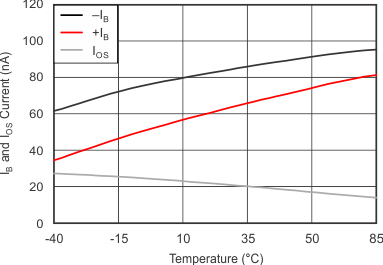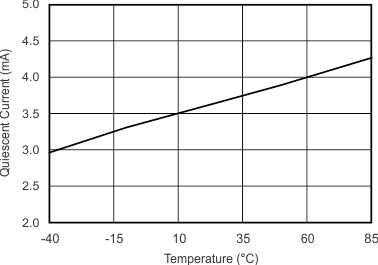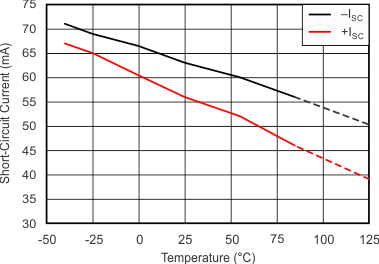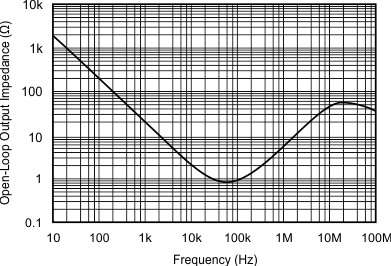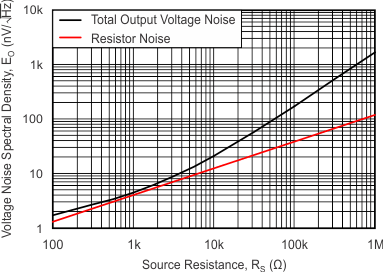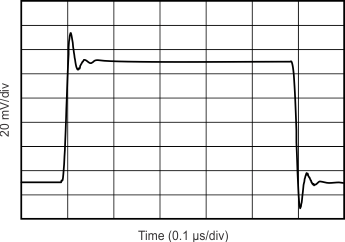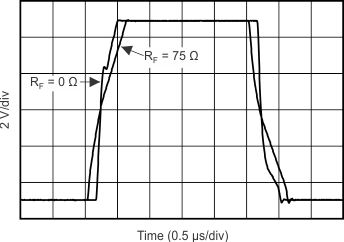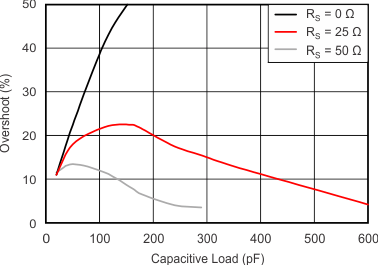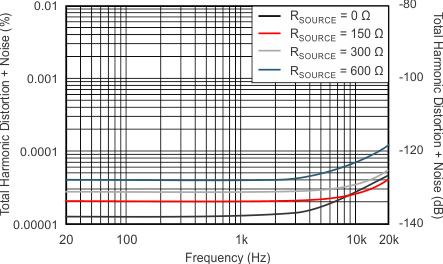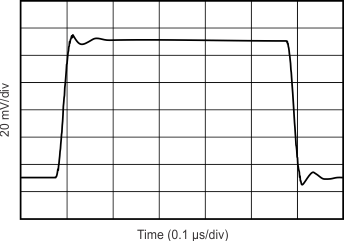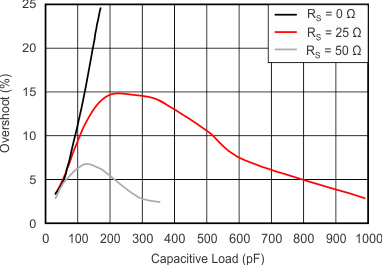SLOS931A November 2015 – November 2015 OPA1612-Q1
PRODUCTION DATA.
- 1 Features
- 2 Applications
- 3 Description
- 4 Revision History
- 5 Pin Configuration and Functions
- 6 Specifications
- 7 Parameter Measurement Information
- 8 Detailed Description
- 9 Application and Implementation
- 10Power-Supply Recommendations
- 11Layout
- 12Device and Documentation Support
- 13Mechanical, Packaging, and Orderable Information
Package Options
Mechanical Data (Package|Pins)
- D|8
Thermal pad, mechanical data (Package|Pins)
Orderable Information
6 Specifications
6.1 Absolute Maximum Ratings
over operating free-air temperature range (unless otherwise noted)(1)| MIN | MAX | UNIT | ||
|---|---|---|---|---|
| VS(2) | Supply voltage | 40 | V | |
| Input voltage | (V–) – 0.5 | (V+) + 0.5 | V | |
| Input current (all pins except power-supply pins) | ±10 | mA | ||
| Output short-circuit(2) | Continuous | |||
| TA | Operating temperature | –55 | 125 | °C |
| TJ | Junction temperature | 200 | °C | |
| Tstg | Storage temperature | –65 | 150 | °C |
(1) Stresses beyond those listed under Absolute Maximum Ratings may cause permanent damage to the device. These are stress ratings only, which do not imply functional operation of the device at these or any other conditions beyond those indicated under Recommended Operating Conditions. Exposure to absolute-maximum-rated conditions for extended periods may affect device reliability.
(2) Short-circuit to VS / 2 (ground in symmetrical dual supply setups), one amplifier per package.
6.2 ESD Ratings
| VALUE | UNIT | |||
|---|---|---|---|---|
| V(ESD) | Electrostatic discharge | Human-body model (HBM), per AEC Q100-002(1) | ±3000 | V |
| Charged-device model (CDM), per AEC Q100-011 | ±1000 | |||
(1) AEC Q100-002 indicates that HBM stressing shall be in accordance with the ANSI/ESDA/JEDEC JS-001 specification.
6.3 Recommended Operating Conditions
over operating free-air temperature range (unless otherwise noted)| MIN | NOM | MAX | UNIT | |
|---|---|---|---|---|
| Supply voltage (V+ – V–) | 4.5 (±2.25) | 36 (±18) | V | |
| Specified temperature | –40 | 85 | °C |
6.4 Thermal Information
| THERMAL METRIC(1) | OPA1612-Q1 | UNIT | |
|---|---|---|---|
| D (SOIC) | |||
| 8 PINS | |||
| RθJA | Junction-to-ambient thermal resistance | 111.9 | °C/W |
| RθJC(top) | Junction-to-case (top) thermal resistance | 26.5 | °C/W |
| RθJB | Junction-to-board thermal resistance | 0.8 | °C/W |
| ψJT | Junction-to-top characterization parameter | 20.9 | °C/W |
| ψJB | Junction-to-board characterization parameter | 1.6 | °C/W |
| RθJC(bot) | Junction-to-case (bottom) thermal resistance | — | °C/W |
(1) For more information about traditional and new thermal metrics, see the Semiconductor and IC Package Thermal Metrics application report, SPRA953.
6.5 Electrical Characteristics: VS = ±2.25 V to ±18 V
At TA = 25°C and RL = 2 kΩ, unless otherwise noted. VCM = VOUT = midsupply, unless otherwise noted.| PARAMETER | TEST CONDITIONS | MIN | TYP | MAX | UNIT | |
|---|---|---|---|---|---|---|
| AUDIO PERFORMANCE | ||||||
| THD+N | Total harmonic distortion + noise | G = +1, f = 1 kHz, VO = 3 VRMS | 0.000015% | |||
| –136 | dB | |||||
| IMD | Intermodulation distortion | SMPTE/DIN two-tone, 4:1 (60 Hz and 7 kHz), G = +1, VO = 3 VRMS |
0.000015% | |||
| –136 | dB | |||||
| DIM 30 (3-kHz square wave and 15-kHz sine wave), G = +1, VO = 3 VRMS | 0.000012% | |||||
| –138 | dB | |||||
| CCIF twin-tone (19 kHz and 20 kHz), G = +1, VO = 3 VRMS |
0.000008% | |||||
| –142 | dB | |||||
| FREQUENCY RESPONSE | ||||||
| GBW | Gain-bandwidth product | G = 100 | 80 | MHz | ||
| G = 1 | 40 | MHz | ||||
| SR | Slew rate | G = –1 | 27 | V/μs | ||
| Full-power bandwidth(1) | VO = 1 VPP | 4 | MHz | |||
| Overload recovery time | G = –10 | 500 | ns | |||
| Channel separation (dual) | f = 1 kHz | –130 | dB | |||
| NOISE | ||||||
| Input voltage noise | f = 20 Hz to 20 kHz | 1.2 | μVPP | |||
| en | Input voltage noise density(2) | f = 10 Hz | 2 | nV/√Hz | ||
| f = 100 Hz | 1.5 | nV/√Hz | ||||
| f = 1 kHz | 1.1 | 1.5 | nV/√Hz | |||
| In | Input current noise density | f = 10 Hz | 3 | pA/√Hz | ||
| f = 1 kHz | 1.7 | pA/√Hz | ||||
| OFFSET VOLTAGE | ||||||
| VOS | Input offset voltage | VS = ±15 V | ±100 | ±500 | μV | |
| dVOS/dT | VOS over temperature(2) | TA = –40°C to +125°C | 1 | 4 | μV/°C | |
| PSRR | Power-supply rejection ratio | VS = ±2.25 V to ±18 V | 0.1 | 1 | μV/V | |
| INPUT BIAS CURRENT | ||||||
| IB | Input bias current | VCM = 0 V | ±60 | ±250 | nA | |
| VCM = 0 V, DRG package only | ±60 | ±300 | nA | |||
| IB over temperature(2) | TA = –40°C to +125°C | 350 | nA | |||
| IOS | Input offset current | VCM = 0 V | ±25 | ±175 | nA | |
| INPUT VOLTAGE RANGE | ||||||
| VCM | Common-mode voltage range | (V–) + 2 | (V+) – 2 | V | ||
| CMRR | Common-mode rejection ratio | (V–) + 2 V ≤ VCM ≤ (V+) – 2 V | 110 | 120 | dB | |
| INPUT IMPEDANCE | ||||||
| Differential | 20k || 8 | Ω || pF | ||||
| Common-mode | 109 || 2 | Ω || pF | ||||
| OPEN-LOOP GAIN | ||||||
| AOL | Open-loop voltage gain | (V–) + 0.2 V ≤ VO ≤ (V+) – 0.2 V, RL = 10 kΩ | 114 | 130 | dB | |
| (V–) + 0.6 V ≤ VO ≤ (V+) – 0.6 V, RL = 2 kΩ | 110 | 114 | dB | |||
| OUTPUT | ||||||
| VOUT | Voltage output | RL = 10 kΩ, AOL ≥ 114 dB | (V–) + 0.2 | (V+) – 0.2 | V | |
| RL = 2 kΩ, AOL ≥ 110 dB | (V–) + 0.6 | (V+) – 0.6 | V | |||
| IOUT | Output current | See Figure 27 | mA | |||
| ZO | Open-loop output impedance | See Figure 28 | Ω | |||
| ISC | Short-circuit current | Source, VS = ±18 V | 55 | mA | ||
| Sink, VS = ±18 V | –62 | mA | ||||
| CLOAD | Capacitive load drive | See Typical Characteristics | pF | |||
| POWER SUPPLY | ||||||
| VS | Specified voltage | ±2.25 | ±18 | V | ||
| IQ | Quiescent current (per channel) | IOUT = 0 A | 3.6 | 4.5 | mA | |
| IQ over Temperature(2) | TA = –40°C to +125°C | 5.5 | mA | |||
| TEMPERATURE RANGE | ||||||
| Specified range | –40 | 125 | °C | |||
| Operating range | –55 | 125 | °C | |||
(1) Full-power bandwidth = SR / (2π × VP), where SR = slew rate.
(2) Specified by design and characterization.
6.6 Typical Characteristics
At TA = 25°, VS = ±15 V, and RL = 2 kΩ, unless otherwise noted.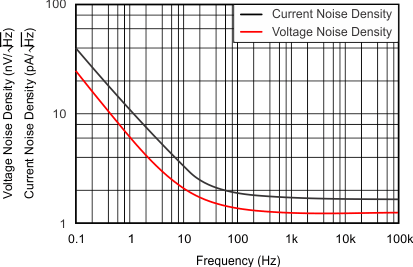
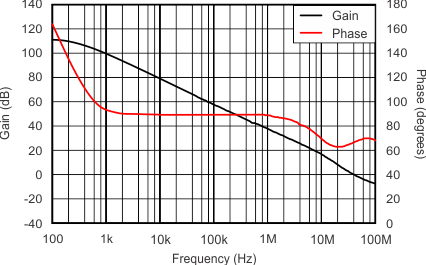
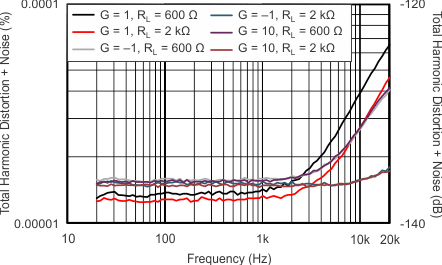
| VOUT = 3VRMS | BW = 80 KHz | |
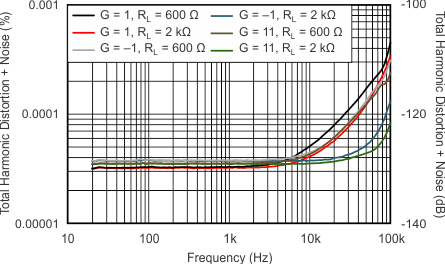
| VOUT = 3VRMS | BW > 500 KHz | |
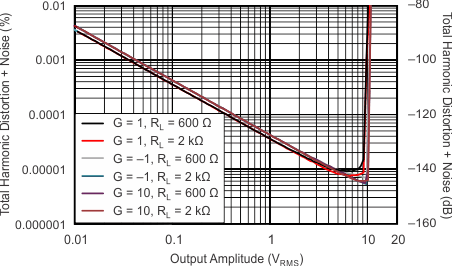
| 1-kHz Signal | BW = 80 KHz | RSOURCE = 0 Ω |
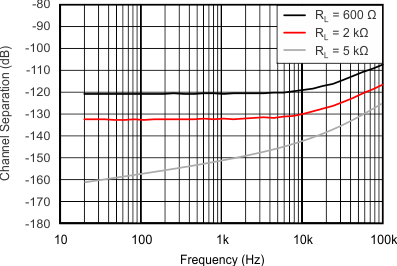
| VOUT = 3.5 VRMS | VS = ±15 V | G = 1 |
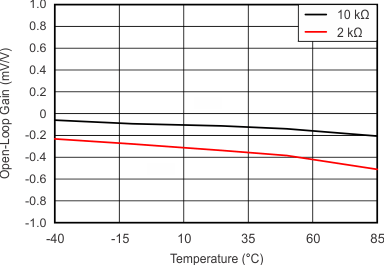
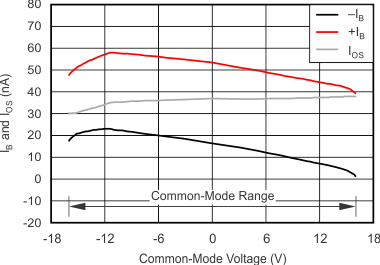
| VS = ±18 V | ||
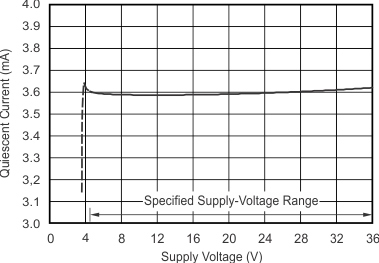
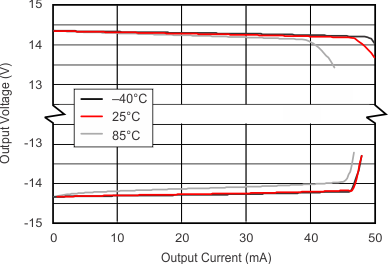
| VS = ±15 V | Both channels driven simultaneously | |
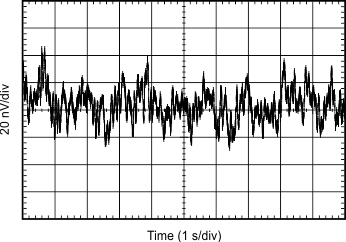
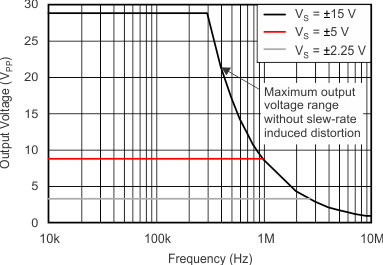
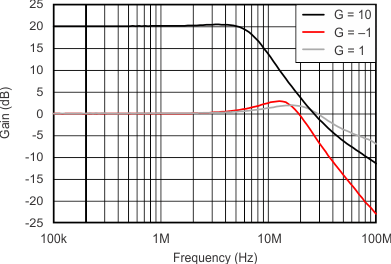
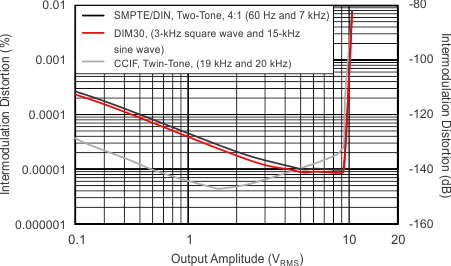
| G = 1 | ||
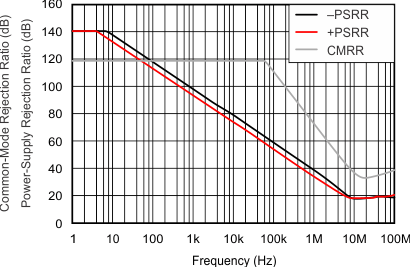
(Referred to Input)
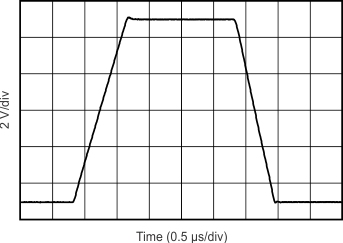
| G = –1 | CL = 50 pF | RL = 2 kΩ |
